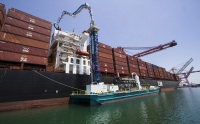The following is the text of a news release from the Port of Long Beach:
(LONG BEACH, Calif.) (Dec. 9) — The Board of Long Beach Harbor Commissioners has approved a new incentive program to reward shipping lines for taking part in testing of new air pollution-control technology for vessels.
The first to benefit from the new incentive will be vessel operators that are participating in the Port of Long Beach demonstration of a barge-mounted emissions-capture system for ships at berth. By waiving the parking or “dockage” fee, the new incentive program is designed to encourage vessel operators to participate in the testing of this barge-mounted system and other similar technology.
An estimated 40 vessel calls each year will be eligible for this incentive over the next two years. In addition to the incentive, the port’s Technology Advancement Program provides funding for inventors to test their clean-air technology.
“This incentive will allow more ships to participate in these important demonstration projects, so we are very happy to offer it. As the Green Port, the Port of Long Beach is committed to being a leader in air pollution reduction and elimination. We’ve made great strides in that area, but we’re far from finished,” said Harbor Commission President Doug Drummond.
Shore power, which reduces air pollution by allowing docked ships to shut down shipboard engines and plug in for clean power, is installed at all of the port’s container shipping terminals. But there is also a need for at-berth emissions control when shore power is not feasible.
Currently, the barge-based Advanced Maritime Emissions Control System, or AMECS, is undergoing testing at the port. The AMECS uses a 115-foot-high tower mounted on a barge to connect to a ship and vacuum up emissions. The gases are sent through filters and scrubbers remove pollutants. The system is seeking approval from state regulators to qualify as an alternative to shore power for containerships and will also be tested on other types of cargo ships.
Although the port has made significant progress in improving air quality, ships remain the largest source of port-related air pollution. A top priority for the port’s Technology Advancement Program is to find and demonstrate technologies to reduce emissions from ships. The new incentive aims to encourage participation in these types of demonstrations.
The Port of Long Beach is one of the world’s premier seaports, a gateway for trans-Pacific trade and a trailblazer in goods movement and environmental stewardship. With 140 shipping lines connecting Long Beach to 217 seaports, the port handles $180 billion in trade annually, supporting hundreds of thousands of Southern California jobs.

